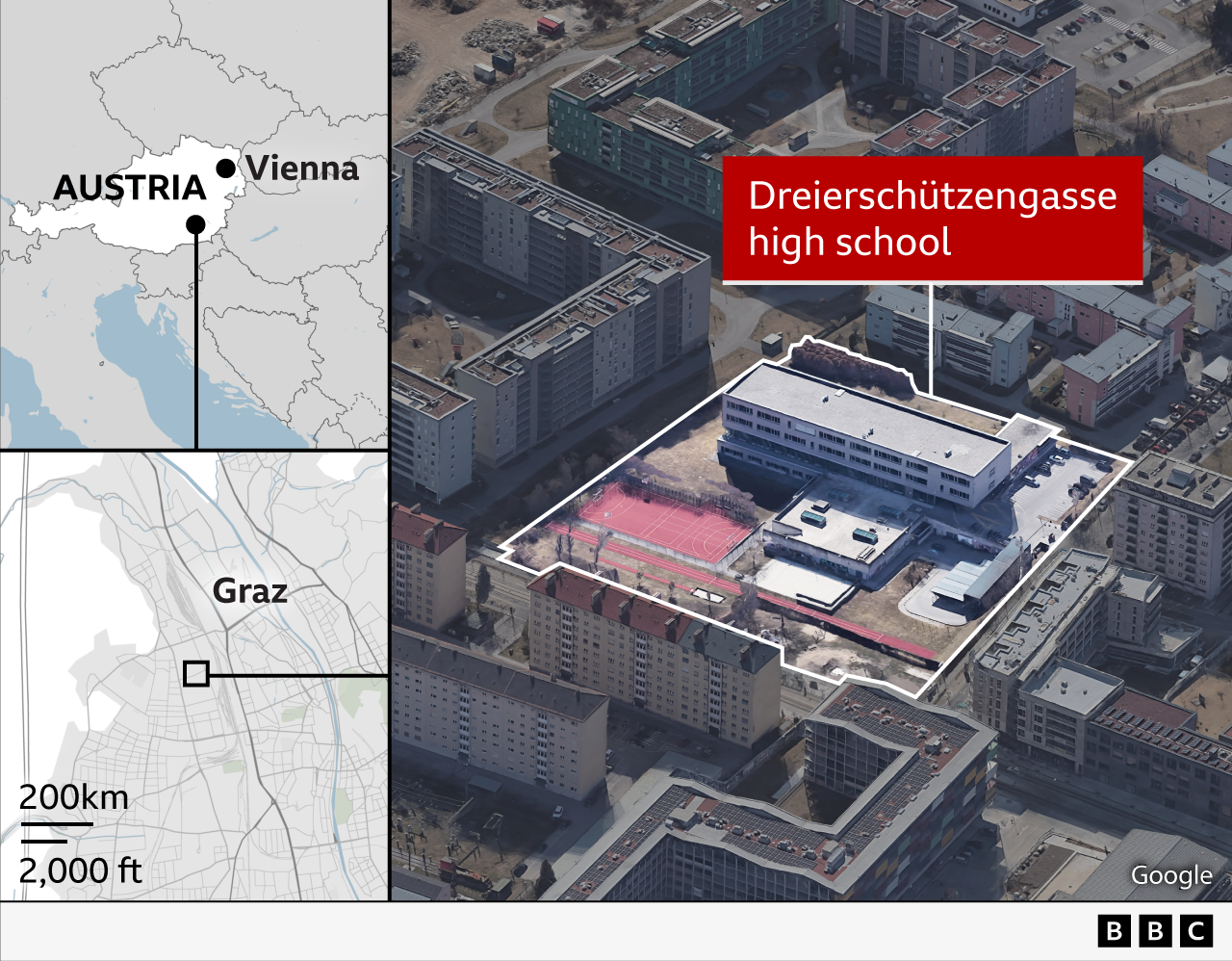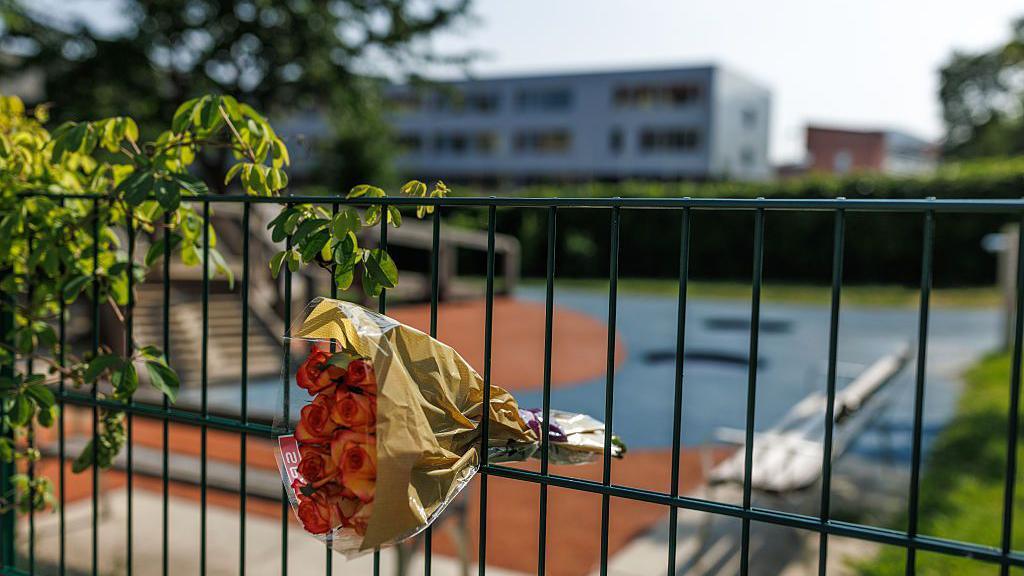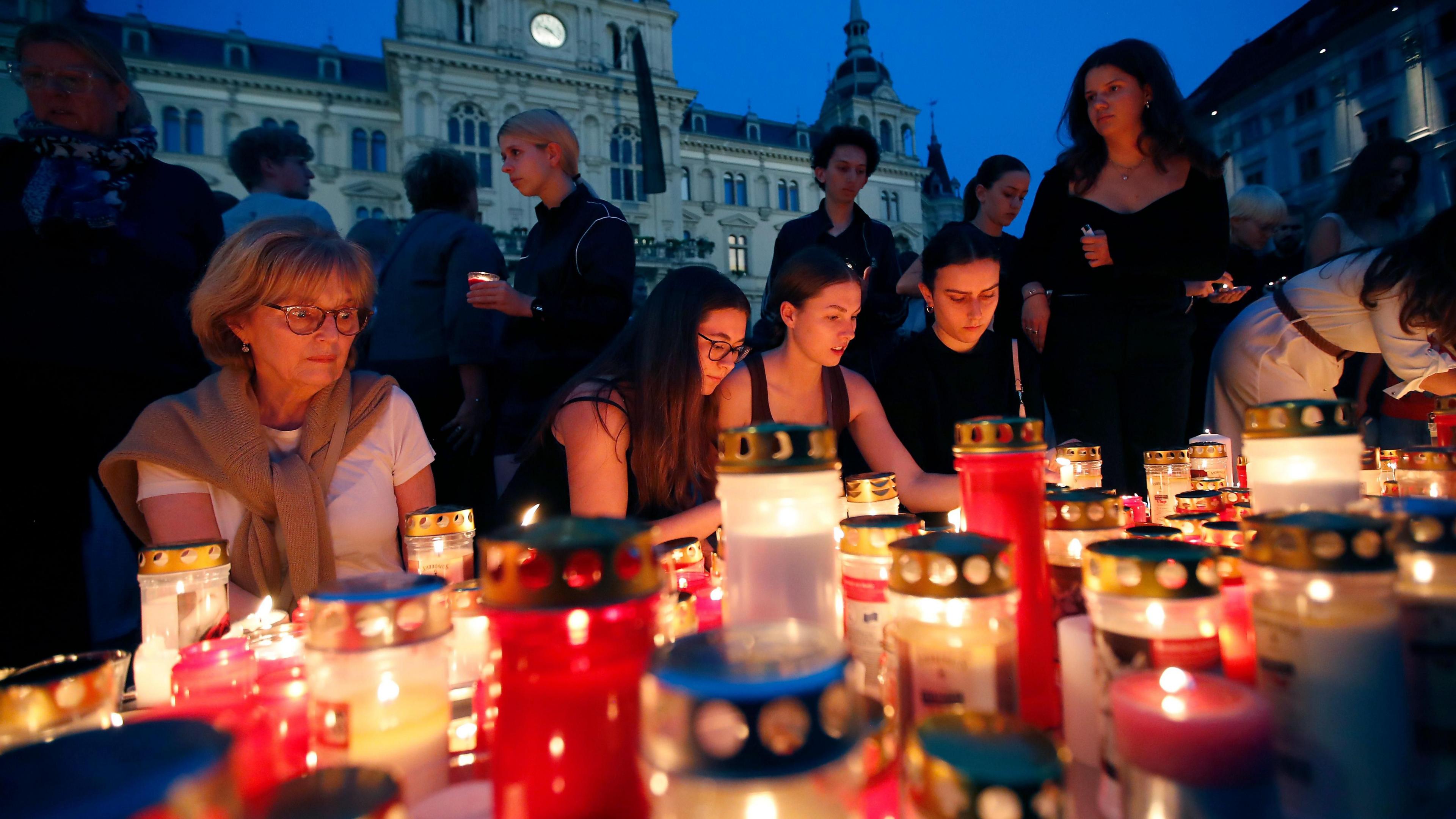What we know about Austria school shooting

- Published
Students were sitting in their classrooms at a secondary school in Graz when a 21-year-old Austrian man shot dead nine people, before killing himself.
Twelve people were injured in Tuesday morning's violence, with one person dying hours later in hospital from their injuries.
The incident was the deadliest mass shooting in Austria's recent history and the country has declared three days of mourning.
Police are still investigating why the gunman - a former student who did not graduate - carried out the attack.
Here is what we know so far.
What happened?
The first shot echoed through Dreierschützengasse secondary school, in the north-west of Graz, close to the main train station, at about 10:00 local time (09:00 BST), initially sparking confusion as to what was happening.
"Was that a shot? That can't be true. Something must have fallen at the construction site across the street," a 17-year-old student, identified as F, said to his friends, according to the Kleine Zeitung newspaper.
One student told Die Presse that when shots rang out, his teacher immediately locked the classroom.
Another student told the paper that at first she thought the shots were firecrackers, but "then there was screaming, and we ran".
Paul Nitsche, a religious studies teacher at the school, told the AFP news agency he was in a classroom when he heard a "bang" followed by the sound of bullet casings hitting the floor of the corridor.
"Something snapped inside me, I jumped up, and decided to run," he said.
As he fled, he caught a glimpse of the shooter. "As I ran down the stairs, I thought to myself, 'This isn't real".
He said he realised what had happened when he "saw a student lying on the floor and a teacher was there".
Local resident Astrid, who lives in a building next to the school, told the BBC she heard 30 or 40 shots. Her husband Franz called the police.
"We saw one pupil at the window - it looked like he was getting ready to jump out... but then he went back inside," Franz said.
The couple later saw the students had "got out of the school on the ground floor, from the other side" where they "gathered on the street", Franz said.
The shooter took his own life in a school bathroom shortly after the gun attack, the authorities said.
The first emergency calls reached police at exactly 10:00, with the first patrol arriving on scene at 10:06, police said on Wednesday. Shortly after, a Cobra tactical unit, which handles attacks and hostage situations, and other specialist units arrived.
Police brought the situation under control in 17 minutes. More than 300 police in total were deployed to the school.
Gunshots heard and students evacuate in videos filmed at Austrian school

Who are the victims?
Nine students - six girls and three boys - between the ages of 14 and 17 were killed in the shooting, police said. A teacher died of her injuries in hospital.
All were Austrian citizens, except for one Polish citizen.
The victims have not yet been named by the authorities.
One woman, Tores, told BBC News in Graz's main square on Wednesday that she knew one of the boys who had died. He was 17.
"I've know this family for a long time, including the son of the family, and knew that he attended that school. I rang immediately, to ask if everything is OK. Then they let me know at midday, that the boy was one of those slaughtered," she said.
"What happened yesterday is completely awful, the whole of Austria is in mourning," she said. "This is terrible for the whole of Austria."
The other eleven injured people are currently out of danger, police said on Wednesday. They are between the ages of 15 and 26. Eight are from Austria, two from Romania and one from Iran.

What do we know about the shooter?
The 21-year-old, who has not yet been named, was an Austrian man from the wider Graz region who acted alone, police said.
He lived with his single mother, who is also Austrian, in the Graz-Umgebung district, police said in a press release on Wednesday.
His father, who is originally from Armenia, had not lived in the same household since their separation.
He was a former Dreierschützengasse student who did not graduate from the school, Interior Minister Gerhard Karner told a news conference on Tuesday.
In a statement on Wednesday, police said they found a "farewell letter", "farewell video", a non-functional pipe bomb and apparently abandoned plans for a bomb attack during a search of the suspect's home.
He legally owned the pistol and shotgun used in the attack, police added.
Police said they are still investigating a possible motive.
What are Austria's gun laws?
Austria has one of the most heavily armed civilian populations in Europe, with an estimated 30 firearms per 100 persons, according to the Small Arms Survey, an independent research project.
Machine guns and pump action guns are banned, while revolvers, pistols and semi-automatic weapons are allowed only with official authorisation. Rifles and shotguns are permitted with a firearms licence or a valid hunting licence, or for members of traditional shooting clubs.
School shootings are rare. There have been a few incidents over the years that have involved far fewer casualties:
In 2018, a 19-year-old was shot by another youth in Mistelbach, north of Vienna
In 2012 in St Pölten, a pupil was shot dead by his father
In 1997, in Zöbern, a 15-year-old killed a teacher and seriously injured another
In 1993, a 13-year-old boy in Hausleiten seriously injured the head teacher and then killed himself
Mass shootings in schools - resulting in four or more deaths, excluding the killer - are even rarer, outside the US. The mass shooting in Graz is only the eighth in Europe since 2000.

Austria's most violent gun attack in recent years took place in the heart of Vienna in November 2020. Four people were killed and 22 injured when a convicted jihadist ran through the centre of the city opening fire, before he was eventually shot by police.
Tuesday's shooting took place almost a decade after three people were killed when a man drove his car into crowds in Graz on 20 June 2015.
Fanny Gasser, a journalist for the Austrian daily newspaper Kronen Zeitung, told BBC News the school was likely unprepared for the possibility of an attack.
"We are not living in America, we are living in Austria, which seems like a very safe space."
Related topics
- Published11 June

- Published10 June
